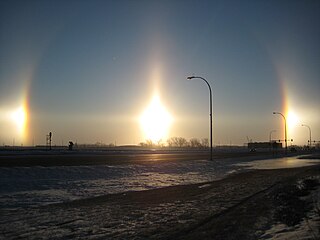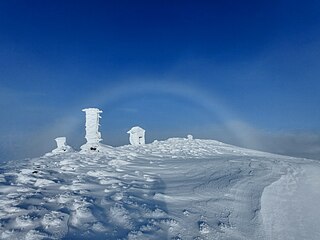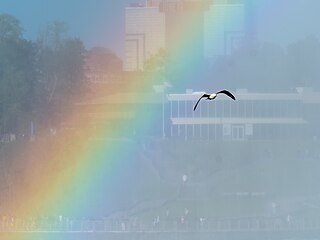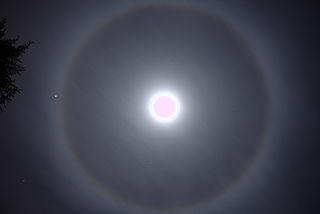
A glory is an optical phenomenon, resembling an iconic saint's halo around the shadow of the observer's head, caused by sunlight or moonlight interacting with the tiny water droplets that comprise mist or clouds. The glory consists of one or more concentric, successively dimmer rings, each of which is red on the outside and bluish towards the centre. Due to its appearance, the phenomenon is sometimes mistaken for a circular rainbow, but the latter has a much larger diameter and is caused by different physical processes.

A sun dog or mock sun, also called a parhelion in meteorology, is an atmospheric optical phenomenon that consists of a bright spot to one or both sides of the Sun. Two sun dogs often flank the Sun within a 22° halo.

A halo is an optical phenomenon produced by light interacting with ice crystals suspended in the atmosphere. Halos can have many forms, ranging from colored or white rings to arcs and spots in the sky. Many of these appear near the Sun or Moon, but others occur elsewhere or even in the opposite part of the sky. Among the best known halo types are the circular halo, light pillars, and sun dogs, but many others occur; some are fairly common while others are extremely rare.

In meteorology, a corona is an optical phenomenon produced by the diffraction of sunlight or moonlight by individual small water droplets and sometimes tiny ice crystals of a cloud or on a foggy glass surface. In its full form, a corona consists of several concentric, pastel-colored rings around the celestial object and a central bright area called an aureole. The aureole is often the only visible part of the corona and has the appearance of a bluish-white disk which fades to reddish-brown towards the edge. The angular diameter of a corona depends on the sizes of the water droplets involved; smaller droplets produce larger coronae. For the same reason, the corona is the most pronounced when the size of the droplets is most uniform. Coronae differ from halos in that the latter are formed by refraction from comparatively large rather than small ice crystals. The diffraction pattern is called an Airy disk.

An anthelion is a rare optical phenomenon of the halo family. It appears on the parhelic circle opposite to the Sun as a faint white spot, not unlike a sundog, and may be crossed by an X-shaped pair of diffuse arcs.

A rainbow is an optical phenomenon caused by refraction, internal reflection and dispersion of light in water droplets resulting in a continuous spectrum of light appearing in the sky. The rainbow takes the form of a multicoloured circular arc. Rainbows caused by sunlight always appear in the section of sky directly opposite the Sun. Rainbows can be caused by many forms of airborne water. These include not only rain, but also mist, spray, and airborne dew.

A circumhorizontal arc is an optical phenomenon that belongs to the family of ice halos formed by the refraction of sunlight or moonlight in plate-shaped ice crystals suspended in the atmosphere, typically in actual cirrus or cirrostratus clouds. In its full form, the arc has the appearance of a large, brightly spectrum-coloured band running parallel to the horizon, located far below the Sun or Moon. The distance between the arc and the Sun or Moon is twice as far as the common 22-degree halo. Often, when the halo-forming cloud is small or patchy, only fragments of the arc are seen. As with all halos, it can be caused by the Sun as well as the Moon.

The circumzenithal arc, also called the circumzenith arc (CZA), upside-down rainbow, and the Bravais arc, is an optical phenomenon similar in appearance to a rainbow, but belonging to the family of halos arising from refraction of sunlight through ice crystals, generally in cirrus or cirrostratus clouds, rather than from raindrops. The arc is located at a considerable distance above the observed Sun and at most forms a quarter of a circle centered on the zenith. It has been called "a smile in the sky", its first impression being that of an upside-down rainbow. The CZA is one of the brightest and most colorful members of the halo family. Its colors, ranging from violet on top to red at the bottom, are purer than those of a rainbow because there is much less overlap in their formation.

A parhelic circle is a type of halo, an optical phenomenon appearing as a horizontal white line on the same altitude as the Sun, or occasionally the Moon. If complete, it stretches all around the sky, but more commonly it only appears in sections. If the halo occurs due to light from the Moon rather than the Sun, it is known as a paraselenic circle.

A 22° halo is an atmospheric optical phenomenon that consists of a halo with an apparent radius of approximately 22° around the Sun or Moon. Around the Sun, it may also be called a sun halo. Around the Moon, it is also known as a moon ring, storm ring, or winter halo. It forms as sunlight or moonlight is refracted by millions of hexagonal ice crystals suspended in the atmosphere. Its radius, as viewed from Earth, is roughly the length of an outstretched hand at arm's length.

A 120° parhelion is a relatively rare halo, an optical phenomenon occasionally appearing along with very bright sun dogs when ice crystal-saturated cirrus clouds fill the atmosphere. The 120° parhelia are named for appearing in pair on the parhelic circle ±120° from the sun.

Tangent arcs are a type of halo, an atmospheric optical phenomenon, which appears above and below the observed Sun or Moon, tangent to the 22° halo. To produce these arcs, rod-shaped hexagonal ice crystals need to have their long axis aligned horizontally.

A circumscribed halo is a type of halo, an optical phenomenon typically in the form of a more or less oval ring that circumscribes the circular 22° halo centred on the Sun or Moon. As the Sun rises above 70° it essentially covers the 22° halo. Like many other halos, it is slightly reddish on the inner edge, facing the Sun or Moon, and bluish on the outer edge.
An infralateral arc is a rare halo, an optical phenomenon appearing similar to a rainbow under a white parhelic circle. Together with the supralateral arc they are always located outside the seldom observable 46° halo, but in contrast to supralateral arcs, infralateral arcs are always located below the parhelic circle.

Cloud iridescence or irisation is a colorful optical phenomenon that occurs in a cloud and appears in the general proximity of the Sun or Moon. The colors resemble those seen in soap bubbles and oil on a water surface. It is a type of photometeor. This fairly common phenomenon is most often observed in altocumulus, cirrocumulus, lenticular, and cirrus clouds. They sometimes appear as bands parallel to the edge of the clouds. Iridescence is also seen in the much rarer polar stratospheric clouds, also called nacreous clouds.

A false sunrise is any of several atmospheric optical phenomena in which the Sun appears to have risen, but is actually still some distance below the horizon. A number of different atmospheric conditions can be responsible for this effect, all of which divert the sunlight in such a way as to allow it to reach the observer's eye, thereby giving the impression that the light comes directly from the Sun itself. The spread of light can sometimes be deceivingly similar to a true sun.

Atmospheric optics is "the study of the optical characteristics of the atmosphere or products of atmospheric processes .... [including] temporal and spatial resolutions beyond those discernible with the naked eye". Meteorological optics is "that part of atmospheric optics concerned with the study of patterns observable with the naked eye". Nevertheless, the two terms are sometimes used interchangeably.
In atmospheric optics, a photometeor is a bright object or other optical phenomenon appearing in the Earth's atmosphere when sunlight or moonlight creates a reflection, refraction, diffraction or interference under particular circumstances. The most common examples include halos, rainbows, fogbows, cloud iridescences, glories, Bishop's rings, coronas, crepuscular rays, sun dogs, light pillars, mirages, scintillations, and green flashes.

A Lowitz arc is an optical phenomenon that occurs in the atmosphere; specifically, it is a rare type of ice crystal halo that forms a luminous arc which extends inwards from a sun dog (parhelion) and may continue above or below the sun.

Optical phenomena are any observable events that result from the interaction of light and matter.


















